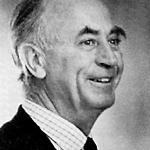Person
Swinbank, William Christopher (1913 - 1973)
FAA

William Christopher Swinbank
Details
- Born
- 8 May 1913
Easington Village, Durham, England - Died
- 28 December 1973
- Occupation
- Meteorologist and Physicist
Summary
Bill Swinbank was a Chief Research Scientist with the CSIRO from 1961 to 1971 when he went to the National Center for Atmospheric Research in Boulder, USA, as Director of the National Hail Research Experiment.
Details
Chronology
- 1961 - 1971
- Career position - Chief Research Scientist, Commonwealth Scientific and Industrial Research Organisation (CSIRO), Australia
- 1970 -
- Award - Fellow, Australian Academy of Science
- 1971 - c. 1973
- Career position - Director of the National Hail Research Experiment, National Centre for Atmospheric Research, Boulder, United States of America
Related entries
Published resources
Journal Articles
- 'Obituary: William Christopher Swinbank', Australian Physicist, 11 (3) (1974), 56. Details
- Priestley, C. H. B., 'William Christopher Swinbank', Records of the Australian Academy of Science, 3 (1) (1975), 76-92. http://www.publish.csiro.au/paper/HR9750310076.htm. Details
Resources
- Wikidata, http://www.wikidata.org/entity/Q66737948. Details
- 'Swinbank, W C (19130508-19731228)', Trove, National Library of Australia, 2009, https://nla.gov.au/nla.party-987823. Details
Resource Sections
- Priestley, C. H. B., 'William Christopher Swinbank 1913-1973', in Australian Academy of Science Biographical Memoirs, Australian Academy of Science, 2006, https://www.science.org.au/fellowship/fellows/biographical-memoirs/william-christopher-swinbank-1913-1973. Details
See also
- Federation and Meteorology, 2001, http://www.austehc.unimelb.edu.au/fam/index_s.html. Details
Digital resources
McCarthy, G.J.
Created: 20 October 1993, Last modified: 24 July 2018
- Foundation Supporter - Committee to Review Australian Studies in Tertiary Education
